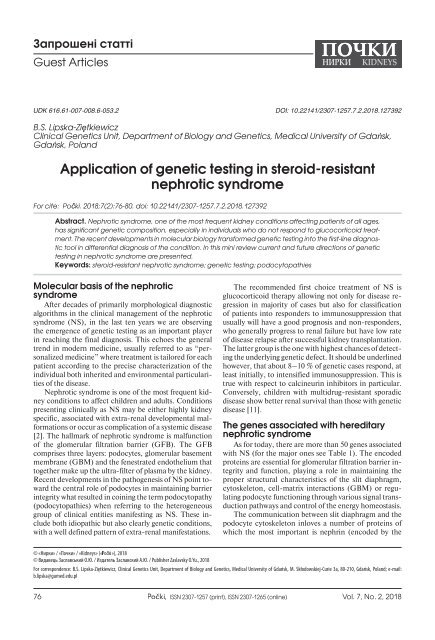Журнал "Почки" том 7, №2 (2018г.)
Create successful ePaper yourself
Turn your PDF publications into a flip-book with our unique Google optimized e-Paper software.
Запрошені статті<br />
Guest Articles<br />
UDK 616.61-007-008.6-053.2 DOI: 10.22141/2307-1257.7.2.2018.127392<br />
B.S. Lipska-Ziętkiewicz<br />
Clinical Genetics Unit, Department of Biology and Genetics, Medical University of Gdańsk,<br />
Gdańsk, Poland<br />
Application of genetic testing in steroid-resistant<br />
nephrotic syndrome<br />
For cite: Počki. 2018;7(2):76-80. doi: 10.22141/2307-1257.7.2.2018.127392<br />
Abstract. Nephrotic syndrome, one of the most frequent kidney conditions affecting patients of all ages,<br />
has significant genetic composition, especially in individuals who do not respond to glucocorticoid treatment.<br />
The recent developments in molecular biology transformed genetic testing into the first-line diagnostic<br />
tool in differential diagnosis of the condition. In this mini review current and future directions of genetic<br />
testing in nephrotic syndrome are presented.<br />
Keywords: steroid-resistant nephrotic syndrome; genetic testing; podocytopathies<br />
Molecular basis of the nephrotic<br />
syndrome<br />
After decades of primarily morphological diagnostic<br />
algorithms in the clinical management of the nephrotic<br />
syndrome (NS), in the last ten years we are observing<br />
the emergence of genetic testing as an important player<br />
in reaching the final diagnosis. This echoes the general<br />
trend in modern medicine, usually referred to as “personalized<br />
medicine” where treatment is tailored for each<br />
patient according to the precise characterization of the<br />
individual both inherited and environmental particularities<br />
of the disease.<br />
Nephrotic syndrome is one of the most frequent kidney<br />
conditions to affect children and adults. Conditions<br />
presenting clinically as NS may be either highly kidney<br />
specific, associated with extra-renal developmental malformations<br />
or occur as complication of a systemic disease<br />
[2]. The hallmark of nephrotic syndrome is malfunction<br />
of the glomerular filtration barrier (GFB). The GFB<br />
comprises three layers: podocytes, glomerular basement<br />
membrane (GBM) and the fenestrated endothelium that<br />
together make up the ultra-filter of plasma by the kidney.<br />
Recent developments in the pathogenesis of NS point toward<br />
the central role of podocytes in maintaining barrier<br />
integrity what resulted in coining the term podocytopathy<br />
(podocytopathies) when referring to the heterogeneous<br />
group of clinical entities manifesting as NS. These include<br />
both idiopathic but also clearly genetic conditions,<br />
with a well defined pattern of extra-renal manifestations.<br />
The recommended first choice treatment of NS is<br />
glucocorticoid therapy allowing not only for disease regression<br />
in majority of cases but also for classification<br />
of patients into responders to immunosuppression that<br />
usually will have a good prognosis and non-responders,<br />
who generally progress to renal failure but have low rate<br />
of disease relapse after successful kidney transplantation.<br />
The latter group is the one with highest chances of detecting<br />
the underlying genetic defect. It should be underlined<br />
however, that about 8–10 % of genetic cases respond, at<br />
least initially, to intensified immunosuppression. This is<br />
true with respect to calcineurin inhibitors in particular.<br />
Conversely, children with multidrug-resistant sporadic<br />
disease show better renal survival than those with genetic<br />
disease [11].<br />
The genes associated with hereditary<br />
nephrotic syndrome<br />
As for today, there are more than 50 genes associated<br />
with NS (for the major ones see Table 1). The encoded<br />
proteins are essential for glomerular filtration barrier integrity<br />
and function, playing a role in maintaining the<br />
proper structural characteristics of the slit diaphragm,<br />
cytoskeleton, cell-matrix interactions (GBM) or regulating<br />
podocyte functioning through various signal transduction<br />
pathways and control of the energy homeostasis.<br />
The communication between slit diaphragm and the<br />
podocyte cytoskeleton inloves a number of proteins of<br />
which the most important is nephrin (encoded by the<br />
© «Нирки» / «Почки» / «Kidneys» (« »), 2018<br />
© Видавець Заславський О.Ю. / Издатель Заславский А.Ю. / Publisher Zaslavsky O.Yu., 2018<br />
For correspondence: B.S. Lipska-Ziętkiewicz, Clinical Genetics Unit, Department of Biology and Genetics, Medical University of Gdańsk, M. Skłodowskiej-Curie 3a, 80-210, Gdańsk, Poland; e-mail:<br />
b.lipska@gumed.edu.pl<br />
76 , ISSN 2307-1257 (print), ISSN 2307-1265 (online) Vol. 7, No. 2, 2018















